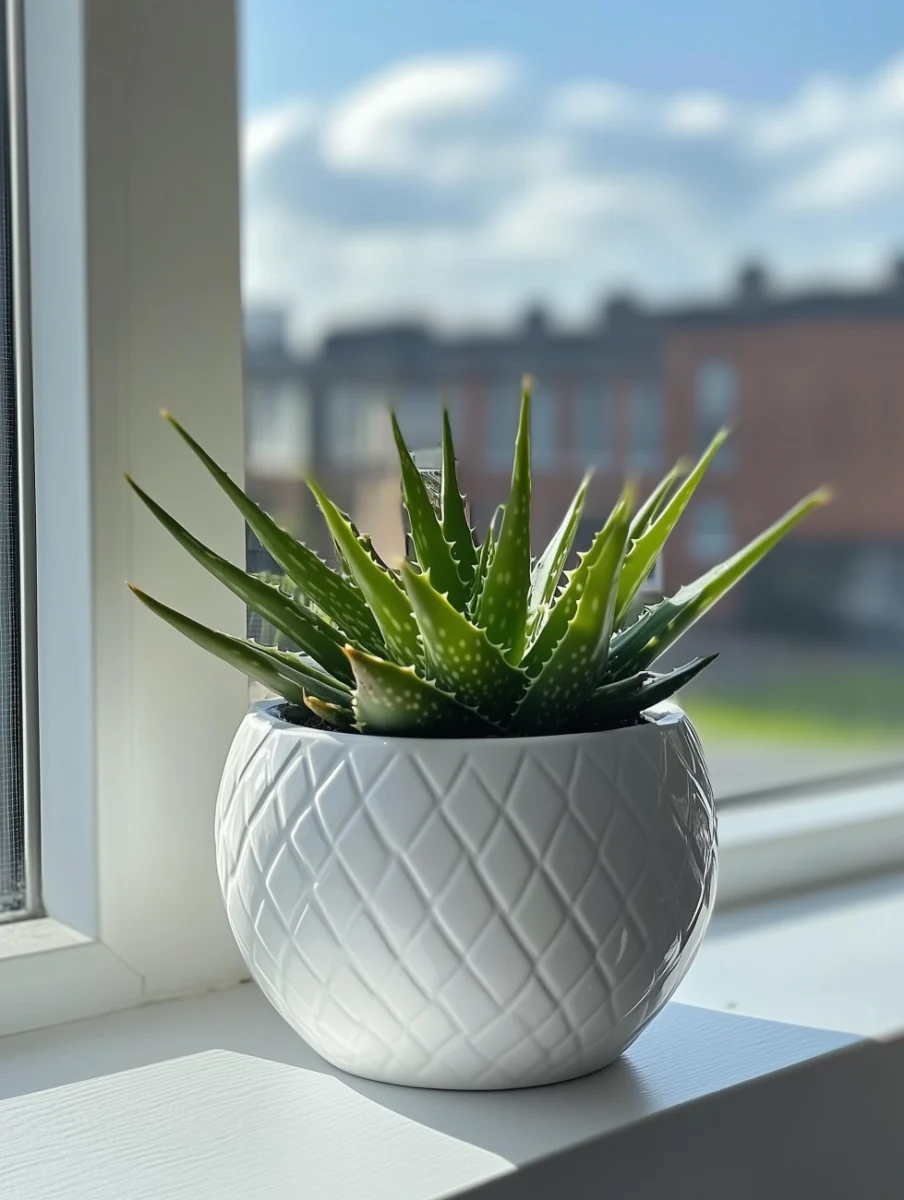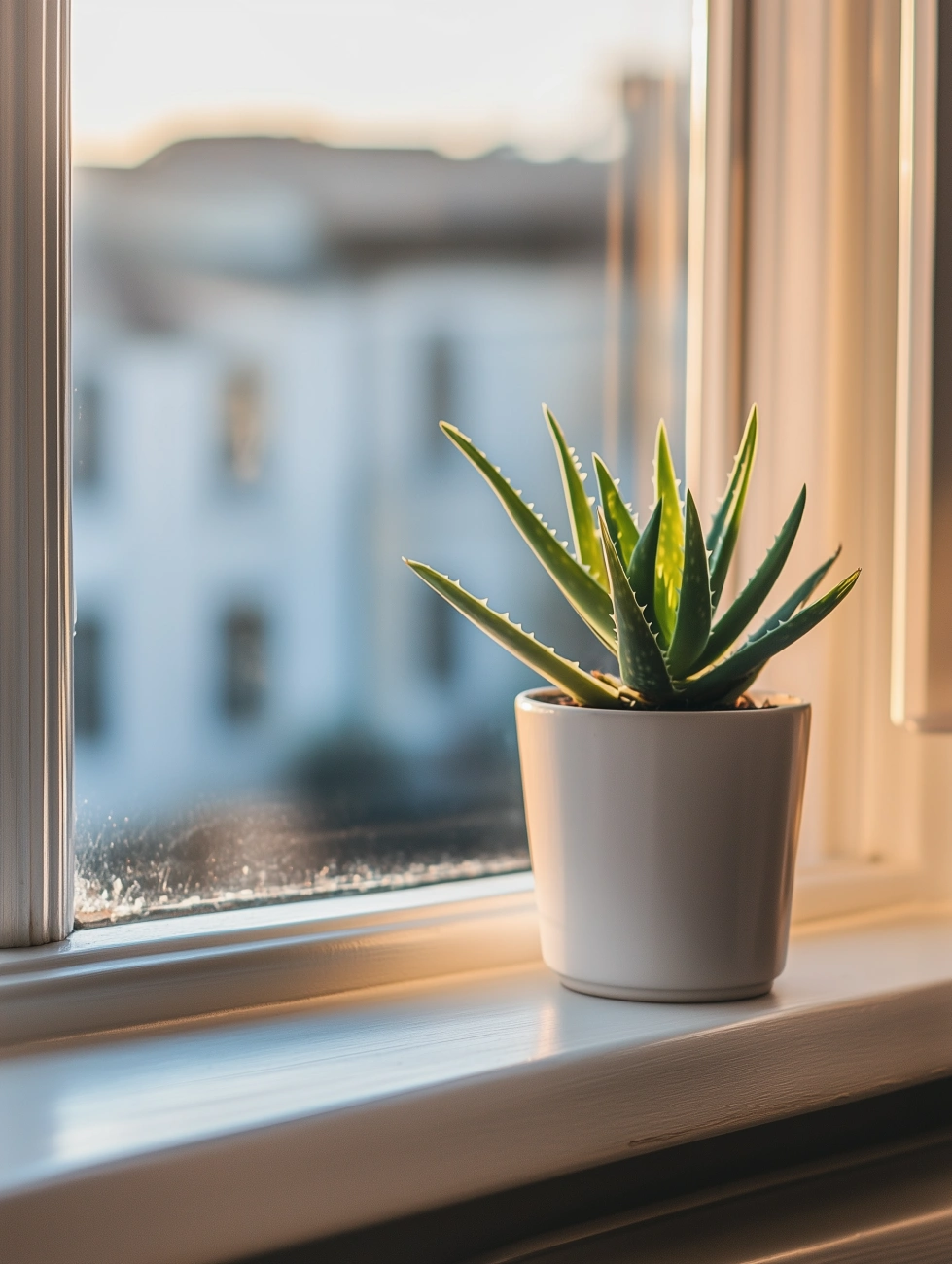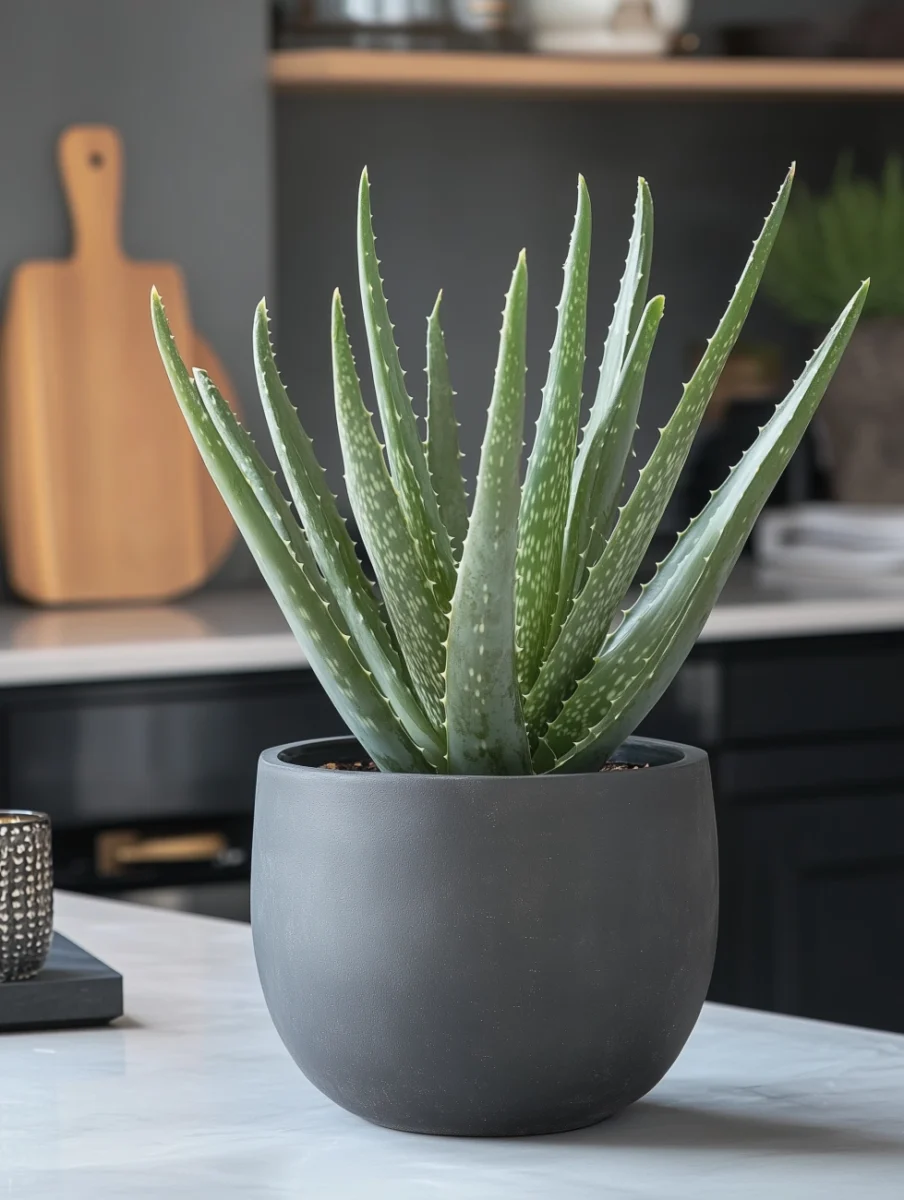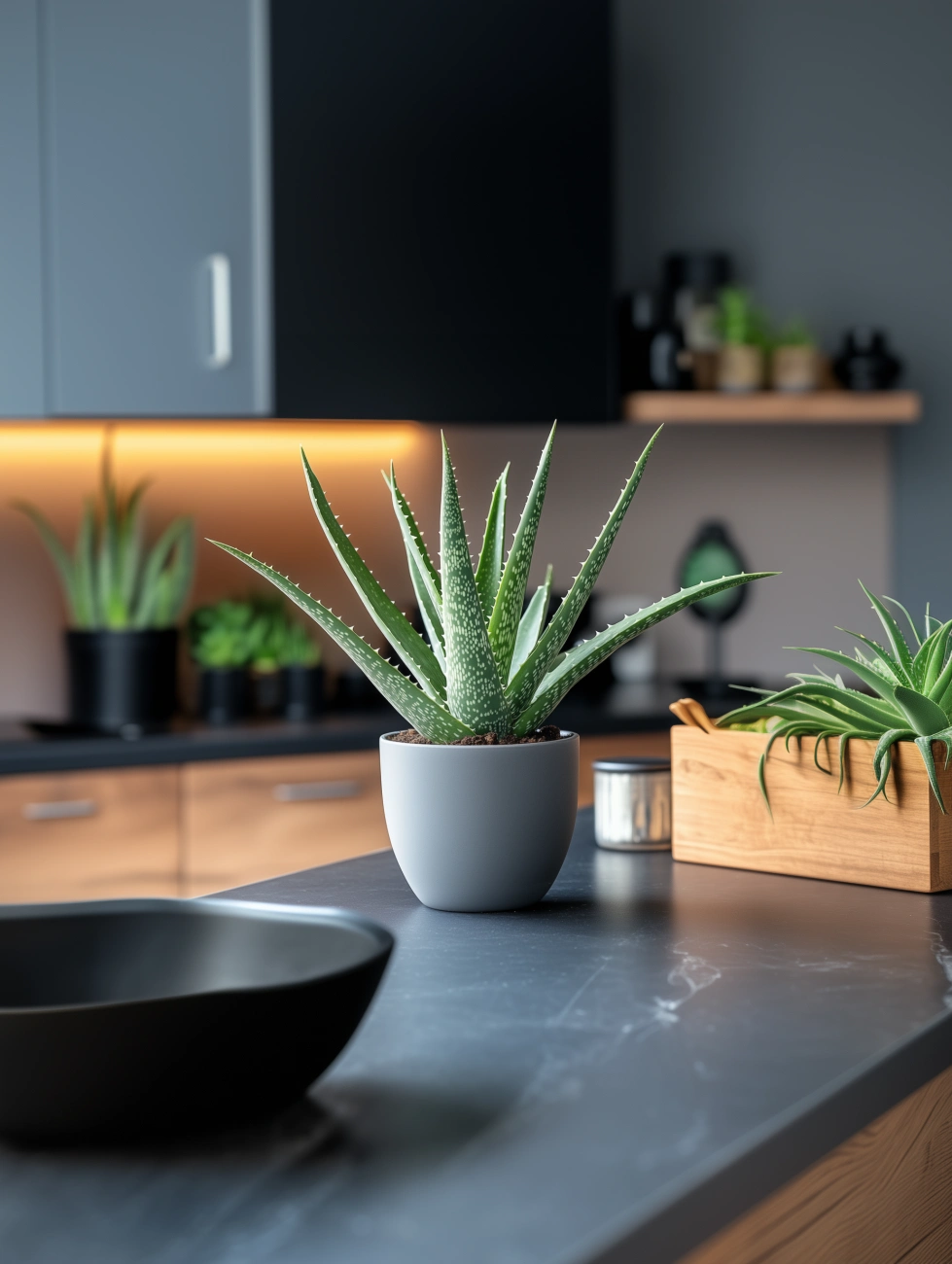
Aloe vera (Aloe barbadensis), with its spiky, fleshy leaves and soothing gel, makes an excellent addition to any indoor plant collection. This succulent native to the arid regions of the Arabian Peninsula thrives in sandy, well-draining soils and warm temperatures between 55°F and 80°F, mimicking its natural desert habitat.
Its striking rosette form and grey-green colour add architectural interest to sunny windowsills, kitchen counters, or bathroom shelves where it can serve both decorative and practical purposes.
Aloe vera is an easy-to-grow houseplant that forgives neglect, making it perfect for beginners or busy plant enthusiasts. Its drought-tolerant nature means you’ll only need to water thoroughly every 7-14 days in summer, allowing the soil to dry completely between waterings.
This medicinal plant has been valued for centuries for its gel, which can be harvested fresh from your own plant to soothe minor burns, cuts, and skin irritations – providing both beauty and functionality in your home.
Growing aloe vera indoors requires minimal effort but delivers maximum rewards. Place your plant in bright, indirect sunlight, though it will tolerate partial sun conditions. Use a terracotta pot with drainage holes and a gritty, well-draining cactus or succulent soil mix to prevent root rot. Your aloe will thrive with occasional attention and can even produce elegant tubular flowers when mature and properly cared for.

Key Takeaways
- Aloe vera thrives in bright light with infrequent watering, making it an ideal low-maintenance houseplant for beginners.
- Plant in well-draining, gritty soil using a pot with drainage holes to prevent root rot and ensure healthy growth.
- This dual-purpose plant offers both striking architectural beauty and practical medicinal benefits from its soothing gel.
Characteristics Of Aloe Vera
Aloe vera is a striking succulent plant native to North Africa that has become an incredibly popular houseplant worldwide. With its distinctive rosette form, it features thick, fleshy green leaves that grow from a central point.
The leaves are the most recognisable feature, growing up to 50cm long in mature plants. They’re triangular in shape with serrated edges that have small teeth or spines. When healthy, the leaves display a beautiful bluish-green colour.
Inside these remarkable leaves lies the plant’s most treasured asset – the clear, gel-like substance that has made aloe vera famous for its healing properties.
Key Characteristics:
- Plant type: Succulent
- Size: Typically 30-60cm tall and wide when mature
- Leaf colour: Bluish-green
- Flowers: Tubular yellow or orange blooms on tall spikes (rare indoors)
Aloe vera occasionally produces tall flower stalks with tubular yellow or orange blooms when grown in optimal conditions, though flowering is rare for indoor specimens.
The plant has earned nicknames like “burn plant” and “medicine plant” due to its therapeutic uses. Its gel contains compounds with anti-inflammatory and antiseptic properties that have been used for centuries.
As a houseplant, aloe vera is remarkably self-sufficient. It stores water in its thick leaves, giving it excellent drought tolerance and making it perfect for forgetful waterers or busy plant parents.
When happy, an aloe vera plant will produce offsets (often called “pups”) around its base, allowing you to propagate new plants with minimal effort.

How To Grow Aloe Vera
Growing aloe vera at home is straightforward when you understand its basic needs. This resilient succulent thrives with minimal care as long as you provide the right light, soil, and watering conditions.
Light Requirements
Aloe vera plants love bright light but can suffer in intense direct sunlight. Position your aloe in a spot that receives bright, indirect light for most of the day. A south or west-facing windowsill often works brilliantly.
During winter months, your plant may need additional light. If you notice it stretching or leaning towards the light source, this indicates it needs more brightness.
In summer, some light shade during the hottest part of the day prevents leaf scorching. While aloe can tolerate full sun once acclimated, introducing it gradually helps prevent shock and sunburn.
Indoor aloes typically show their happiness with compact growth and vibrant colouring. If leaves appear pale or elongated, try moving to a brighter location.
Soil And Feeding Requirements
Aloe vera demands well-draining soil that prevents root rot. Create an ideal growing medium by mixing:
- 1 part quality potting soil
- 1 part coarse sand or perlite
- 1 part small gravel or pumice
Commercial cactus potting mix works well as a base, with added drainage materials. Always select pots with drainage holes to prevent water accumulation at the roots.
Aloe vera doesn’t require frequent feeding. Apply a diluted cactus fertiliser at half-strength once in spring and once in summer. Avoid feeding during autumn and winter when growth naturally slows.
Over-fertilising causes more harm than good, potentially burning the root system. If your plant looks healthy with firm, plump leaves, it likely has adequate nutrition.
When repotting (needed every 2-3 years), choose a container only slightly larger than the current one. Aloe actually performs better when slightly pot-bound.
Water And Humidity Requirements
Proper watering is crucial for aloe vera success. The golden rule: wait until the soil is completely dry before watering thoroughly. In summer, this typically means watering every 7-14 days, while in winter, reduce to once monthly.
When watering, saturate the soil completely until water flows from the drainage holes. This encourages deeper root growth. Always empty any water that collects in the saucer beneath the pot.
Signs of overwatering include:
- Soft, mushy leaves
- Yellowing foliage
- Root rot
- Mould on soil surface
Underwatered aloe shows thin, concave leaves and browning at the tips. The plant stores water in its fleshy leaves, so it can withstand occasional neglect better than over-attention.
Aloe vera thrives in average household humidity and doesn’t require misting. In fact, excess humidity can promote fungal issues. These desert natives prefer dry air conditions.

Pruning And Leaf Maintenance
Aloe vera requires minimal pruning, but some maintenance helps keep plants healthy. Remove any damaged, diseased or dying leaves by cutting them at the base using clean, sharp scissors or secateurs.
When harvesting leaves for medicinal use, select the outermost, mature leaves. Cut them close to the stem, making a clean angled cut. Never remove more than one-third of the plant’s leaves at once.
If your aloe develops elongated stems or becomes leggy, this suggests insufficient light. Consider relocating the plant rather than pruning the stems, as cutting the main stem can damage the plant.
Dust the leaves occasionally with a soft, damp cloth. This keeps the pores open for proper plant respiration and photosynthesis. Avoid using leaf shine products, as these can damage the protective coating on aloe leaves.
If your plant produces a tall flower stalk, you can leave it to bloom or remove it to direct energy back to leaf growth.
Propagation
Propagating aloe vera is simple using offsets or ‘pups’ that develop around the base of mature plants. These small plantlets can be separated when they reach about 8-10 cm in height and have several leaves.
To propagate:
- Remove the parent plant from its pot
- Gently separate pups that have their own root system
- Allow the separated pups to form a callus by leaving them in a warm, dry spot for 1-2 days
- Plant in appropriate cactus mix
- Wait 1-2 weeks before watering to prevent rotting
Unlike some succulents, aloe vera doesn’t propagate well from leaf cuttings. The offset method offers the highest success rate.
Newly propagated pups need slightly more frequent watering until established. Place them in bright, indirect light and protect from intense sun for the first few weeks. Within 3-4 weeks, you should notice new growth, indicating successful establishment.
Winter Care Of Aloe Vera
Aloe vera plants go dormant during winter months, requiring different care than during active growing seasons. Your plant will need less attention but still demands some specific considerations to stay healthy.
Watering Schedule
During winter, significantly reduce how often you water your aloe vera. Allow the soil to dry out completely between waterings.
- Water once every 4-6 weeks (indoors)
- Only water if the soil is completely dry
- Use room temperature water to avoid shocking the roots
Light Requirements
Aloe plants need bright, indirect sunlight even in winter. Place your plant near a south or west-facing window where it can receive at least 6 hours of indirect light daily. Rotate the pot occasionally to ensure even growth.
Temperature Considerations
Keep your aloe vera in a spot with consistent temperatures between 13-18°C. Avoid placing it near radiators, heaters or draughty windows. Temperature fluctuations can stress the plant and cause leaf damage.
Fertiliser
Don’t fertilise your aloe vera during winter. The plant doesn’t need additional nutrients whilst dormant, and fertilising could harm it.
Common Winter Issues
Watch for these problems during the colder months:
- Pale leaves (insufficient light)
- Soft, mushy roots (overwatering)
- Brown leaf tips (too cold or draughty)
- Leggy growth (insufficient light)
Resist the urge to repot your aloe during winter. Wait until spring when the plant resumes active growth and can better handle the stress of transplanting.

Common Problems And Solutions
Growing aloe vera indoors can present a few challenges, but most issues are easily resolved with proper care. Here are the most common problems and their solutions:
Overwatering
One of the most frequent issues with aloe plants is overwatering. Signs include soft, mushy leaves and yellowing. Allow the soil to dry completely between waterings, typically watering every 2-3 weeks in summer and monthly in winter.
Root Rot
This serious condition results from excessive moisture around the roots. If your aloe has blackened, mushy roots and a foul smell, you’ll need to act quickly:
- Remove the plant from its pot
- Cut away any rotted roots with clean, sharp scissors
- Allow the plant to dry for 24 hours
- Repot in fresh, well-draining cactus soil
Pests
Aloe plants occasionally attract pests, particularly when stressed. The most common include:
- Mealybugs: These appear as white, cotton-like clusters. Wipe them away with a cotton swab dipped in rubbing alcohol.
- Spider mites: Look for fine webbing and stippled leaves. Treat with a gentle spray of water or neem oil solution.
Leggy Growth
If your aloe becomes stretched and pale, it’s not receiving enough light. Gradually move it to a brighter location, ideally near a south or west-facing window.
Offsets and Pups
While not a problem, the small plantlets (pups) that grow from the base can crowd the mother plant. When pups are about 1/5 the size of the parent, you can gently separate them and pot them individually.
Other Similar Plants To Grow
If you enjoy growing aloe vera, there are several similar succulent plants that thrive under similar conditions and make excellent houseplants. These plants share aloe’s preference for well-draining soil and tolerance for occasional neglect.
Haworthia varieties are perfect companions to aloe vera. These small rosette-forming succulents have similar care requirements but typically stay more compact, making them ideal for smaller spaces. They feature striking patterns and translucent “windows” on their leaves.
Gasteria plants (also known as “ox tongue”) offer similar ease of care with distinctive thick, tongue-shaped leaves. They’re perfect for beginners and tolerate lower light conditions better than many other succulents.
Snake Plants (Sansevieria) share aloe’s resilience and air-purifying qualities. Their striking upright leaves add architectural interest to your indoor garden whilst requiring minimal attention.
Here’s a quick comparison of these aloe alternatives:
| Plant | Light Needs | Watering | Special Features |
|---|---|---|---|
| Haworthia | Bright indirect | When soil dries completely | Compact size, window-like leaf patterns |
| Gasteria | Medium to bright indirect | Every 2-3 weeks | Tongue-shaped leaves, flowers on tall stalks |
| Snake Plant | Low to bright indirect | Monthly in winter, bi-weekly in summer | Air purifying, upright growth |
| Echeveria | Bright indirect to direct | When soil is completely dry | Rosette form, comes in various colours |
For beginners, Jade Plants (Crassula ovata) offer similar drought-tolerance and minimal fuss with their attractive round leaves and tree-like growth habit.
Martin Cole has been an avid plant lover and gardener for more than 20 years and loves to talk and write about gardening. In 2006 he was a finalist in the BBC Gardener of the Year competition. He is a member of the National dahlia Society.
He previously lived in London and Sydney, Australia, where he took a diploma course in Horticultural studies and is now based in North Berwick in Scotland. He founded GardeningStepbyStep.com in 2012. The website is aimed at everybody who loves plants or has been bitten by the gardening bug and wants to know more.
Gardening Step by Step has been cited by Thompson and Morgan, the UK’s largest mail order plant retailer, as a website that publishes expert gardening content.

